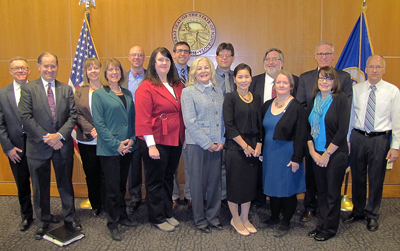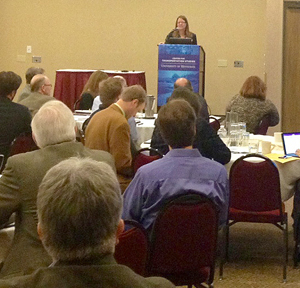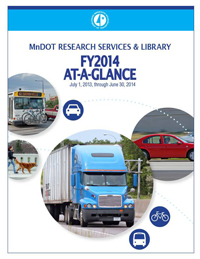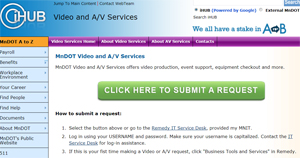 |
|

|
 |
TABLE of CONTENTS
 |
MnDOT receives Governorís Continuous Improvement Award for streamlining project approval process |
By Rich Kemp

MnDOT receives a Governorís Continuous Improvement award for a joint venture with the Federal Highway Administration and the Metropolitan Council. Representing the agencies at the award ceremony were from the left: Scott McBride, Metro District engineer; Commissioner Charlie Zelle; Tracy Hatch, deputy commissioner, chief operating officer and chief financial officer; Pat Bursaw, Metro District; Brian Isaacson, Metro District; Ryan Gaug, Metro District; Susan Moe, FHWA; Brian Gage, Office of Transportation System Management; Trang Chu, Office of Transportation System Management; Mark Filipi, Metropolitan Council; Heidi Schalberg, Metropolitan Council; Pat Born, Metropolitan Council; Jody Carr, Office of Transportation System Management; and Dave Pehoski, Business Services. Photo by Adam Giorgi, Department of Administration |
The Governor’s Continuous Improvement Awards celebrate individual and organizational achievements that have increased the productivity and efficiency of state government services, while improving the delivery and responsiveness of customer service. MnDOT received the award Dec. 9 for a joint venture with the Federal Highway Administration and the Metropolitan Council.
The initiatives were selected for making government work better for Minnesotans, while also saving time and taxpayer dollars. As part of Gov. Mark Dayton’s ongoing initiative to make government work better for Minnesotans, state agencies were asked to find innovative ways to deliver better services and implement efficiencies.
“This is the third year MnDOT submitted nominations and the first time receiving the award,” said Sue Stein, Corporate Services Division director.“The quality of nominations has improved each year, which makes the competition even stiffer. The group definitely has a reason to celebrate. They did great work with great results.”
MnDOT received the award for Approving Road Construction Projects 62 Percent Sooner. This improvement reduces the time needed for approvals to construction project cost and scope, reduces duplicative paperwork and errors, and reduces the uncertainty and risk while altering small parts of construction projects.
When state and local construction projects with federal funding in the Twin Cities metro area have changes to cost or scope prior to construction letting, a request for the changes must be approved by MnDOT, the Metropolitan Council and the Federal Highway Administration.
The approval process was lengthy, typically 12-16 weeks, and often resulted in costly delays. Projects with these delays at times missed opportunities to start construction in the spring and summer, and the delays sometimes pushed projects to later years, increasing costs and creating a backlog of projects to complete.
Working together, the agencies reduced the amount of paperwork and the length of wait times to streamline the approval process. Thanks to the reforms, project changes are being approved 62 percent faster – saving taxpayers money and getting projects finished quicker.
The multi-agency team used a Kaizen process to help with this improvement. The process helps teams identify waste in a given business process and rapidly implement improvements to that process. Kaizen is Japanese for "change for the better."
Through the Kaizen event, the group identified focus areas for improvements for all participating staff and agencies. Focus areas included making improvements to request forms, public meeting process and interagency communication.
Overall, the process of getting approval for a change to a project improved from an average of 16 weeks to six weeks, resulting in a 62 percent reduction of wait time. New processes and tools developed include:
- Creation of process calendars that can be shared with MnDOT project managers, to better communicate the amount of time a project change will take to complete.
- A streamlined amendment process within the Metropolitan Council’s public meeting schedule, reducing the number of public meetings (from five to two) that a project with a minor change needed.
- Creation of a web-based amendment form that replaces Word documents and reduces the number of amendment forms and opportunity for errors.
As a result of the Kaizen event, the group created an ongoing monthly meeting. These monthly interagency meetings allow for clearer communication and face to face meetings to discuss the appropriate way a proposed change should happen. These meetings have reduced the amount of time spent drafting, editing language and waiting for other agencies’ approval. This work is often completed within these meetings. Staff found that the relationships built around these meetings aid in positive communication and understanding of changes, resulting in reduction of time needed for approvals.
The Governor’s Office and the Continuous Improvement Steering Team presented the award during a ceremony at the Department of Revenue Building.
|
 |
|

|
 |
TABLE of CONTENTS
 |
Summit airs perspectives on efficient, competitive freight transportation network |
By Sue Roe

Caitlin Rayman, Federal Highway Administration, speaks to attendees at the Statewide Freight Summit Dec. 5 in Minneapolis. Leaders from the freight community met to share the development of a statewide freight action plan and share perspectives on transportation issues that affect Minnesota industries and the economy. Photo by Erika Witzke, Cambridge Systematics |
Supporting an efficient and competitive freight transportation network in Minnesota was the predominant theme of the Minnesota Statewide Freight Summit Dec. 5 in Minneapolis.
The Center for Transportation Studies hosted the summit in cooperation with MnDOT.
Attendees included shippers, carriers and other private sector organizations involved in logistics and transportation, government officials, and representatives from nonprofit organizations and academic institutions. They participated in interactive discussions and working sessions to help shape the development of a statewide freight action plan. The sessions focused on identifying needs, issues and opportunities, and how to take these opportunities into actions.
“The freight action plan is a tool to help Minnesota compete in the national and global economy,” said John Tompkins, freight project manager. “We’ll need to have an efficient transportation system to compete.”
Commissioner Charlie Zelle, who gave the opening remarks, said one of MnDOT’s most important customer segments are Minnesota-based manufacturers that ship their products over roads and bridges to local, state, national and international markets. He said these businesses rely on safe, efficient multi-modal infrastructure to deliver their products. He said MnDOT can better align its work to support manufacturers’ success and the economic vitality of the region and state by better understanding these customers’ business and transportation needs.
Zelle also said funding transportation should be thought of as an investment instead of an added expense. Investing in infrastructure will require a shift in mindset from expensive short-term fixes toward longer-term solutions.
Keynote speaker Jeffrey Rainey, Greater MSP, told attendees that one of Minnesota's strengths lies in its central location that offers quick access to both coasts and Canada, and shipping on the Great Lakes and Mississippi River.
Rainey said that for Minnesota to take its place on the global stage, it must tell its story, prioritize talent and assert global leadership for its strongest sectors, which includes manufacturing.
Other speakers were Caitlin Rayman of the Federal Highway Administration; Bill Goins, FedEx and chairman of the Minnesota Freight Advisory Committee; and Erika Witzke, Cambridge Systematics, Inc., and Statewide Freight Plan consultant team leader. |
 |
|

|
 |
TABLE of CONTENTS
 |
Automatic flagger assistance devices provide safer way to control traffic through work zones |
|
This video discusses the automatic flagger assistance devices, also known as auto-flaggers. The AFADs are portable traffic control devices. They allow road crews to control the flow of traffic through work zones remotely, without putting flaggers in harm's way. The video showcases a MnDOT project to deploy AFADs for use by district maintenance staff. Video produced by Research Services & Library |
|
 |
|

|
 |
TABLE of CONTENTS
 |
Mitch Rasmussen named new State Aid Division director |

Mitch Rasmussen took over as the State Aid Division director Dec. 8. Photo by Rich Kemp |
Mitch Rasmussen is the new Division Director for the State Aid Division. Rasmussen replaces Julie Skallman, who retired on Dec. 5th.
Rasmussen served as Scott County public works director/county engineer for the past nine years. Previous to that he held positions as Burnsville city engineer, Dakota County construction engineer, and Rice County engineer. He has a bachelor of science in Civil Engineering from South Dakota State University.
“His work in city and county positions, as well as experience in Twin City Metro area and rural counties, brings a great deal of experience to this position,” said Tracy Hatch, deputy commissioner, chief financial officer and chief operating officer. “Mitch has successfully managed many complicated and difficult challenges in his career. He will be a great addition to MnDOT State Aid and the department's senior leadership team.”
Rasmussen started in the position on Monday, Dec. 8. He is located on the 4th floor at Central Office and can be reached at 651-366-4831. |
 |
|

|
 |
TABLE of CONTENTS
 |
Project Management Battle helps improve delivering projects on time, on budget |
|
By Chris Joyce
Editor’s note: This is one in a series of articles illustrating the benefits gained from the Enhancing Financial Effectiveness effort, MnDOT’s Wildly Important Goal. Project Management is one of four strategic focus areas, or Battles, that are leading the EFE charge. The other Battles are Asset Management, Financial Management (divided into two subareas—Efficiencies, and Products and Services), and Information & Outreach. In addition, there are a number of efforts throughout the agency that fall outside these four categories. These projects are called “Other WIG Supporting Activities,” and also contribute overall to enhancing MnDOT’s financial effectiveness.
Delivering road construction projects on time and on budget is a large part of MnDOT’s core business, a challenging task given that there are more than 300 state transportation projects underway annually.
That’s why the Project Management Battle has undertaken an effort during the past year to ensure better schedule and cost management on projects, according to Chris Roy, Office of Project Management and Tech Support director.
To date, the group has reviewed MnDOT’s current policies, guidelines and practices with the intent of improving the schedule and processes for putting projects out for bid (or “letting”). This helps the agency better manage resources and deliver projects on time to meet established letting dates.
For example, when the group started its efforts, Roy said that more than half of MnDOT’s construction projects were being let during the fourth quarter of the fiscal year (April-June). This creates an uneven workload schedule throughout the year, but also puts the state at a disadvantage in the bidding environment where potential contractors are unavailable because they have already assigned resources to other, non-MnDOT projects.
“The later you bid a job during the year, the fewer bidders you have available,” said Jay Hietpas, Office of Project Management and Tech Support.
To address this issue and find a more-balanced distribution throughout the year, the team established goals for project lettings:
- 20 percent in 1st Quarter (July-September)
- 35 percent in 2nd Quarter (October-December)
- 35 percent in 3rd Quarter (January-March)
- 10 percent in 4th Quarter (April-June)
“We’re doing much better,” said Hietpas, who noted that recent figures put the number of projects let during the 4th Quarter at 23 percent. “We haven’t reached the 10 percent goal yet, but we’re trending towards it.”
One of the tools helping MnDOT staff improve schedule management and resource planning is Primavera P6, which guides project managers through a number of processes, including schedule creation, schedule maintenance and role loading (a process that assigns roles and estimates the number of hours to complete a schedule activity).
“We’ve made strides in improving our project schedules by converting the old PPMS (project management) schedules into P6 schedule,” said Greg Paulson, District 6 assistant district engineer for program delivery. “It hasn’t happened overnight, but now all of our FY 2016 schedules are P6 schedules.”
Terry Humbert, District 3 assistant district engineer for program delivery, said one of the greatest benefits of the emphasis on schedule management is a renewed focus on a balanced letting schedule.
“By holding to a balanced letting schedule, we are able to more effectively use our resources to deliver the construction program,” he said. “Communication with Central Office functional groups is becoming easier since we all are sharing a commitment to the same schedule.”
Tom Styrbicki, Metro District Program Delivery Office director, agrees.
“P6 is a tremendous tool to help us manage project schedules and coordinate our program delivery efforts,” he said. “We’ve come a long way toward creating a ‘project management’ culture at MnDOT, and I believe we’re reaching a point where this is becoming our standard way of doing business. Recognition should go out to MnDOT’s professional and dedicated project managers who have made this a success.”
As MnDOT offices and districts improve project management processes, Hietpas sees a lot of benefit for the department.
“We’ll be able to see our peaks and valleys for work earlier, which will help us move resources around where they’re needed, when they’re needed,” he said.
During the year ahead, the Project Management Battle will continue work on the schedule management processes, while it also focuses on the second emphasis area—cost management, which includes reviewing and improving cost estimating and management policies, guidelines and practices that lead to building projects within an approved budget.
Look for the next quarterly report of all four Battles at the end of January 2015.
Learn more:
|
 |
|

|
 |
TABLE of CONTENTS
 |
Research Services & Library releases annual summary |

At-A-Galance, a summary of the Research Services & Library's program is now available online. |
MnDOT Research Services & Library released its annual At-A-Glance, summarizing its research activities from the last fiscal year. The document serves as a quick-reference guide to the research program, and includes project highlights, an overview of the research process and information about the Transportation Research Synthesis program.
During Fiscal Year 2014, Research Services & Library oversaw the completion of 51 research projects as well as MnDOT’s participation in 33 multi-state pooled fund studies. It also focused its efforts on supporting MnDOT’s “wildly important goal” of enhanced financial effectiveness.
“We have taken steps to better quantify the value of our research program, including launching a new initiative to calculate and communicate cost savings and other benefits,” said Linda Taylor, Research Services & Library director. “We also enhanced our Automated Research Tracking System database to include built-in tracking of implementation opportunities, financial benefits, and marketing and technology transfer products.”
The department also has ramped up its marketing and communication efforts, launching the Accelerator newsletter and Crossroads blog, and producing a variety of YouTube videos.
|
 |
|

|
 |
TABLE of CONTENTS
 |
Angie Fonkert, transportation generalist senior, adds role of adjunct faculty to work day |
By Bob Filipczak

Angie Fonkert, District 3 senior transportation generalist, teaches a Materials, Estimating and Specifications class at St. Cloud Technical and Community College. Photo by Bob Filipczak |
Angie Fonkert has a lot on her plate with her full time job as senior transportation generalist, two young children, and her responsibilities as a plow driver in District 3. This fall, she took on one more responsibility as adjunct faculty at St. Cloud Technical and Community College.
Fonkert landed a position teaching a Materials, Estimating and Specifications class because an instructor, 10 years earlier, said she might have a talent for teaching. She applied for an open position last fall and was a bit surprised when she got the job right away.
The one thing that sold her on the idea was that the course would be, for the first time, offered primarily as an online class. That gave her, and her students, some flexibility as they didn’t need to be in the same classroom at the same time every week. But it did not necessarily reduce the workload. Because this was her first time teaching the course, she spent a lot of time preparing the learning materials and then loading them into the online learning system.
The students began the semester learning terminology and reading about bidding requirements and conditions, scope of work and control of work from the MnDOT Spec book. Next, she gave students PowerPoint decks and worksheets on construction materials and basic estimating. Her goal for the class was to give a practical, functional explanation so when the students get jobs, they will have a basic understanding, while learning specifics through work experience.
Her course is a hybrid, meaning she and her students also meet face-to-face three times during the semester. One of those meetings was at the MnDOT Materials Lab in St. Cloud.
“I thought it would be a good learning experience to bring them in and show them how things operate,” said Fonkert. “Instead of just reading about it, they got to see it.”
This was a first-year class at SCTCC and part of the Land Surveying and Civil Engineering Technology program, which Fonkert graduated from 10 years earlier. The program is tied to a four-year Land Surveyor program at St. Cloud State University, but Fonkert said “I try to get across to my students that you can go and do that, but you can also graduate in two years and find a good job.”
She won’t be teaching next semester because of the work load, but Fonkert said it was a great learning experience. |
 |
|

|
 |
TABLE of CONTENTS
 |
Whatís new on the web |
|
Network password reset tutorial
Now you can unlock and reset your password without going through IT Service Desk. It’s simple – just register and store the answers to a series of personal questions that will be used to verify your identity when you wish to unlock your AD account.
First, go to the registration portal and log in. You'll see a web form with 10 personal questions. You must complete at least five of these questions (you can do more if you're an overachiever), and if you have a local administrator (-ADM) account, you must also complete a separate registration for that account as well. Then you're all set! Watch a brief tutorial to see how easy it is.
Then, if you ever get locked out of your account, go to the password reset portal from any MnDOT computer and enter your user ID. You'll be presented with three randomly selected security questions that you completed during the registration process. If you successfully answer the questions, you can set a new password and automatically unlock your network account.
For now, this password reset capability is only available on a MnDOT computer within MnDOT's network, but the Directory Services & Messaging Team is working to allow users to unlock and reset their AD account passwords from anywhere. More details to come.
For more info visit: ihub/itweb/password-reset.html
or contact: *DOT_TIM or TIM.dot@state.mn.us
Video and Audio Visual Services requests now submitted through IT Self Service Remedy System
MnDOT employees will now request all video and audio visual services using Remedy (through IT Self Service). This system will allow MnDOT Video and A/V Services to deliver prompt, accurate and cost effective services to all MnDOT customers, helping to support the WIG of Enhancing Financial Effectiveness.

To request services for video production, video duplication, equipment checkout or event support, go to the Video Services website or access IT Self Service and make your request. |
To request services for video production, video duplication, equipment checkout or event support, simply access IT Self Service and make your request. You can do this one of two ways:
- Log on to IT Self Service, click on Business Tools and Services, click on Video and Audio Visual Services and make your request. Or…
- On iHUB, go to the Video Services website and link to IT Self Service. Follow the instructions to make your request.
We have posted instructions on the Video Services iHUB site to assist you with your requests, or you can contact a Video and A/V Services team member: Gary Andrist, Joel Wenz, Clay Ebeling, Carol Hennekens.
New Library Materials posted on the web
New Library Materials are available at www.mndot.gov/library/newlibmat.html. This issue comes to you with a moving Happy Holiday greeting from MnDOT Library staff. Don’t miss it.
New Library Materials is a compilation of new titles and other resources added to the library collection during the previous month. If you would like to be added to the distribution list, contact pamela.m.gonzalez@state.mn.us or 651-366-3749.
Previous editions of New Library Materials are archived and available at www.dot.state.mn.us/library/recacq-archive.html. For other information requests, contact the Library at 651-366-3791 or e-mail library.dot@state.mn.us, or send requests via the Ask a Librarian web page. |
 |
|
______________________________________________________________________________ -->
| |
|



